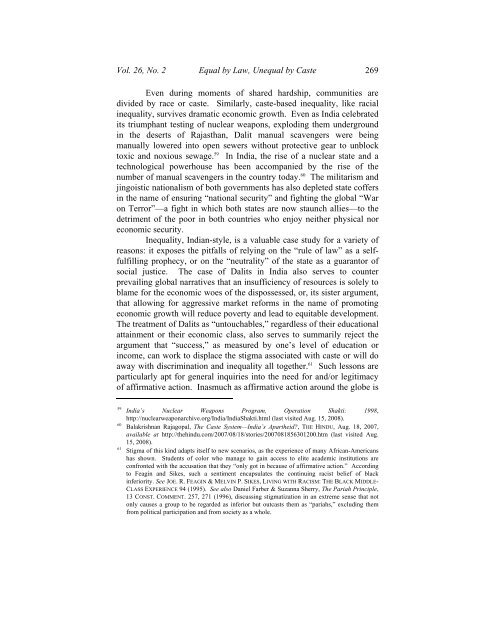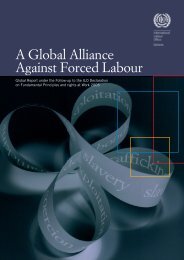268 Wisconsin <strong>International</strong> Law Journalare far more likely to be poor. 54 Moreover, the poverty endured is abject,violent, and virtually inescapable.In both countries, economic progress has not led to equitablegrowth. In the United States—which is the most economically powerfulcountry in the world—and India—whose economic growth is celebratedas a success of the ethos of economic liberalization—the rising tide hasnot lifted all boats; rather, it has caused many to drown, in some cases alltoo literally. Just as African-Americans bore the brunt of HurricaneKatrina in 2005 due to their concentration in the areas where the floodingwas worst, as well as the lethargic response of the U.S. federalgovernment, <strong>Dalit</strong>s too were twice victimized in India’s recent naturaldisasters—first <strong>by</strong> nature, and then <strong>by</strong> the apathy of the state. 55 <strong>Dalit</strong>s areparticularly susceptible to loss of life and property in times of naturaldisasters due to the precarious conditions in which they live. A surveyconducted <strong>by</strong> the National Campaign on <strong>Dalit</strong> Human Rights(“NCDHR”) following catastrophic flooding in the eastern state of Biharin August 2007—which affected 14 million people in the state and killed2,253 in the region—found that <strong>Dalit</strong>s were the worst hit. 56 Relief rarelyreached <strong>Dalit</strong>s, testifying to the fact that “[t]he culture of discriminationwhich runs through Indian society intensifies in times of crisis.” 57 Insome cases, <strong>Dalit</strong>s were forced to wait for their share of relief suppliesuntil all other groups had received aid. 585455565758See MELVIN OLIVER & THOMAS M. SHAPIRO, BLACK WEALTH/WHITE WEALTH: A NEWPERSPECTIVE ON RACIAL INEQUALITY (2nd ed., 2006); THOMAS M. SHAPIRO, THE HIDDEN COSTOF BEING AFRICAN AMERICAN: HOW WEALTH PERPETUATES INEQUALITY (2004); MEIZHU LUI,BARBARA ROBLES & BETSY LEONDAR-WRIGHT, THE COLOR OF WEALTH: THE STORY BEHINDTHE U.S. RACIAL WEALTH DIVIDE (2006).See Scott Shane, After Failures, Government Officials Play Blame Game, N.Y. TIMES, Sept. 5,2005. It has been argued that the Bush administration’s lack of urgent concern about the victimswas because the population, mostly African-American, had never been of electoral significancefor Bush. Or, as rapper Kanye West put it simply, “George Bush doesn’t care about blackpeople.” See MICHAEL ERIC DYSON, COME HELL OR HIGH WATER: HURRICANE KATRINA ANDTHE COLOR OF DISASTER 30 (2006).Amelia Gentleman, Letter from India: In Flood Lands of India, Caste Prejudices Thrive, INT’LHERALD TRIB., Aug. 29, 2007, available at http://www.iht.com/articles/2007/08/29/asia/letter.php.Id.NATIONAL CAMPAIGN ON DALIT HUMAN RIGHTS, DALIT WATCH REPORT ON BIHAR FLOOD,http://www.ncdhr.org.in/latestinterventions/dalit-watch-report (last visited Aug. 15, 2008).<strong>Dalit</strong>s also faced rampant discrimination in the distribution of aid in the wake of the January2001 earthquake and the Indian Ocean tsunami in December 2004. See A GLOBAL CONCERN,supra note 1, at 6; After the Deluge: India’s Reconstruction After the 2004 Tsunami, 17 HUMANRIGHTS WATCH NO. 3, May 2005, at 25.
Vol. 26, No. 2 Equal <strong>by</strong> Law, Un<strong>equal</strong> <strong>by</strong> Caste 269Even during moments of shared hardship, communities aredivided <strong>by</strong> race or <strong>caste</strong>. Similarly, <strong>caste</strong>-based in<strong>equal</strong>ity, like racialin<strong>equal</strong>ity, survives dramatic economic growth. Even as India celebratedits triumphant testing of nuclear weapons, exploding them undergroundin the deserts of Rajasthan, <strong>Dalit</strong> manual scavengers were beingmanually lowered into open sewers without protective gear to unblocktoxic and noxious sewage. 59 In India, the rise of a nuclear state and atechnological powerhouse has been accompanied <strong>by</strong> the rise of thenumber of manual scavengers in the country today. 60 The militarism andjingoistic nationalism of both governments has also depleted state coffersin the name of ensuring “national security” and fighting the global “Waron Terror”—a fight in which both states are now staunch allies—to thedetriment of the poor in both countries who enjoy neither physical noreconomic security.In<strong>equal</strong>ity, Indian-style, is a valuable case study for a variety ofreasons: it exposes the pitfalls of relying on the “rule of <strong>law</strong>” as a selffulfillingprophecy, or on the “neutrality” of the state as a guarantor ofsocial justice. The case of <strong>Dalit</strong>s in India also serves to counterprevailing global narratives that an insufficiency of resources is solely toblame for the economic woes of the dispossessed, or, its sister argument,that allowing for aggressive market reforms in the name of promotingeconomic growth will reduce poverty and lead to equitable development.The treatment of <strong>Dalit</strong>s as “untouchables,” regardless of their educationalattainment or their economic class, also serves to summarily reject theargument that “success,” as measured <strong>by</strong> one’s level of education orincome, can work to displace the stigma associated with <strong>caste</strong> or will doaway with discrimination and in<strong>equal</strong>ity all together. 61 Such lessons areparticularly apt for general inquiries into the need for and/or legitimacyof affirmative action. Inasmuch as affirmative action around the globe is596061India’s Nuclear Weapons Program, Operation Shakti: 1998,http://nuclearweaponarchive.org/India/IndiaShakti.html (last visited Aug. 15, 2008).Balakrishnan Rajagopal, The Caste System—India’s Apartheid?, THE HINDU, Aug. 18, 2007,available at http://thehindu.com/2007/08/18/stories/2007081856301200.htm (last visited Aug.15, 2008).Stigma of this kind adapts itself to new scenarios, as the experience of many African-Americanshas shown. Students of color who manage to gain access to elite academic institutions areconfronted with the accusation that they “only got in because of affirmative action.” Accordingto Feagin and Sikes, such a sentiment encapsulates the continuing racist belief of blackinferiority. See JOE. R. FEAGIN & MELVIN P. SIKES, LIVING WITH RACISM: THE BLACK MIDDLE-CLASS EXPERIENCE 94 (1995). See also Daniel Farber & Suzanna Sherry, The Pariah Principle,13 CONST. COMMENT. 257, 271 (1996), discussing stigmatization in an extreme sense that notonly causes a group to be regarded as inferior but outcasts them as “pariahs,” excluding themfrom political participation and from society as a whole.
- Page 1 and 2: EQUAL BY LAW, UNEQUAL BY CASTE: THE
- Page 3 and 4: Vol. 26, No. 2 Equal by Law, Unequa
- Page 5 and 6: Vol. 26, No. 2 Equal by Law, Unequa
- Page 7 and 8: Vol. 26, No. 2 Equal by Law, Unequa
- Page 9 and 10: Vol. 26, No. 2 Equal by Law, Unequa
- Page 11 and 12: Vol. 26, No. 2 Equal by Law, Unequa
- Page 13: Vol. 26, No. 2 Equal by Law, Unequa
- Page 17 and 18: Vol. 26, No. 2 Equal by Law, Unequa
- Page 19 and 20: Vol. 26, No. 2 Equal by Law, Unequa
- Page 21 and 22: Vol. 26, No. 2 Equal by Law, Unequa
- Page 23 and 24: Vol. 26, No. 2 Equal by Law, Unequa
- Page 25 and 26: Vol. 26, No. 2 Equal by Law, Unequa
- Page 27 and 28: Vol. 26, No. 2 Equal by Law, Unequa
- Page 29 and 30: Vol. 26, No. 2 Equal by Law, Unequa
- Page 31 and 32: Vol. 26, No. 2 Equal by Law, Unequa
- Page 33 and 34: Vol. 26, No. 2 Equal by Law, Unequa
- Page 35 and 36: Vol. 26, No. 2 Equal by Law, Unequa
- Page 37 and 38: Vol. 26, No. 2 Equal by Law, Unequa
- Page 39 and 40: Vol. 26, No. 2 Equal by Law, Unequa
- Page 41 and 42: Vol. 26, No. 2 Equal by Law, Unequa
- Page 43 and 44: Vol. 26, No. 2 Equal by Law, Unequa
- Page 45 and 46: Vol. 26, No. 2 Equal by Law, Unequa
- Page 47 and 48: Vol. 26, No. 2 Equal by Law, Unequa
- Page 49 and 50: Vol. 26, No. 2 Equal by Law, Unequa
- Page 51 and 52: Vol. 26, No. 2 Equal by Law, Unequa
- Page 53 and 54: Vol. 26, No. 2 Equal by Law, Unequa
- Page 55: Vol. 26, No. 2 Equal by Law, Unequa
- Page 58 and 59: 312 Wisconsin International Law Jou
- Page 60 and 61: 314 Wisconsin International Law Jou
- Page 62 and 63: 316 Wisconsin International Law Jou
- Page 64 and 65:
318 Wisconsin International Law Jou
- Page 66 and 67:
320 Wisconsin International Law Jou
- Page 68 and 69:
322 Wisconsin International Law Jou
- Page 70 and 71:
324 Wisconsin International Law Jou
- Page 72 and 73:
326 Wisconsin International Law Jou
- Page 74 and 75:
328 Wisconsin International Law Jou
- Page 76 and 77:
330 Wisconsin International Law Jou
- Page 78 and 79:
332 Wisconsin International Law Jou
- Page 80 and 81:
334 Wisconsin International Law Jou
- Page 82 and 83:
336 Wisconsin International Law Jou
- Page 84 and 85:
338 Wisconsin International Law Jou
- Page 86 and 87:
340 Wisconsin International Law Jou
- Page 88 and 89:
342 Wisconsin International Law Jou
















